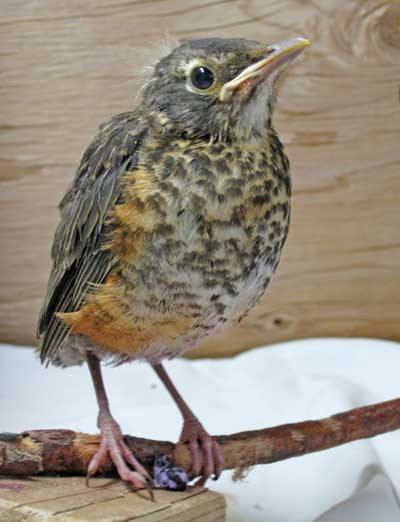By Shona Aitken
A couple of weeks ago our phone rang and woman’s voice said: “Hi. I know you don’t care for little birds, but a robin flew into my window and my neighbor said you could give me advice on how to take care of it.”
What a perfect educational opportunity. Two misconceptions about Wolf Hollow rolled into one.
In a few moments chatting on the phone we were able to assure the caller that we do care for lots of songbirds and would be happy to provide care for the injured robin. The only thing we couldn’t do was give her advice on how to take care of it herself.
The robin was soon in our care, receiving treatment for a head injury, but the caller’s comments made us realize how easy it is for people to have misleading ideas about an organization such as Wolf Hollow. Consider just this one call
Myth: We don’t treat “little birds.”
Fact: In 2014 we treated over 140 songbirds, which is around 30 percent of our patient total for the year.
We raise tiny nestlings when their nests are destroyed and care for injured birds that are attacked by cats, fly into windows or are hit by cars. Chickadees and wrens may be small, but they are just as essential in the ecosystem as hawks and owls.
Myth: We give people advice on how to care for wild animals themselves.
Fact: We can’t do that because it is illegal and puts both people and animals at risk.
Having an injured owl in your living room or raising raccoon kits in your bathroom could lead to all kinds of injuries or diseases for you or your pets. It is also not as easy to care for wildlife as you might think (Don’t believe everything you read on the internet!).
Wild animals need very specific diets and care to recover from injury or grow up healthy and strong. They also need to behave like wild animals so they have the best chance of survival once they are released. An animal that is kept in a home and gets used to being around people and pets is going to be at a real disadvantage when it meets others of its own kind for the first time or walks boldly up to the first person or dog it meets.
Wildlife rehabilitators have the specialized foods, medications, enclosures and skills to give wild animals the best possible chance, so, if you find an injured or orphaned wild animal, please call Wolf Hollow, 378 5000.
So that takes care of these particular Wolf Hollow myths, but there are more.
One golden oldie that resurfaces from time to time is the myth that we only take small  mammals and birds so we can feed them to larger carnivores. If it wasn’t so sad, we could get a good chuckle out of that one, but we are too busy feeding the blackbird nestlings every 30 minutes, preparing food for ducklings and caring for the young squirrels or doves.
mammals and birds so we can feed them to larger carnivores. If it wasn’t so sad, we could get a good chuckle out of that one, but we are too busy feeding the blackbird nestlings every 30 minutes, preparing food for ducklings and caring for the young squirrels or doves.
Don’t believe me? Take a look at the “Currently in Care” list on our web site, www.wolfhollowwildlife.org.
This approach would certainly reduce our food bills (which are over $3,000 each year for raptor food alone) and our caseload, (to a few very fat eagles and owls), but would defeat the purpose as the smaller creatures are just as important in the natural scheme of things as the big, glamorous ones, and are injured or orphaned by human activities just as often.
I don’t know how they start, but I’m sure there will be many more myths about what we do at Wolf Hollow. However, now you know some facts and can tell your friends, who can tell their neighbors, and so on. I wonder how long it will take for the non-myths to get around.
— Editor’s note: Shona Aitken is education coordinator of Wolf Hollow Wildlife Rehabilitation Center




